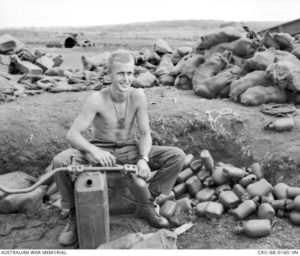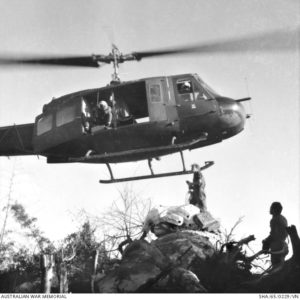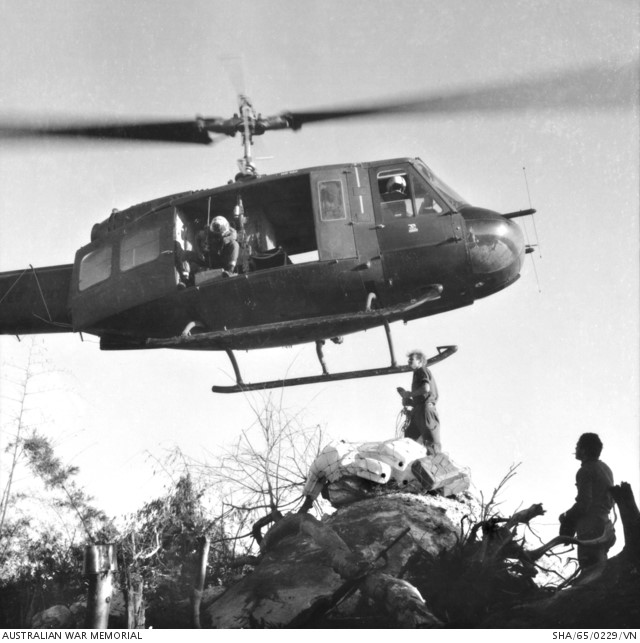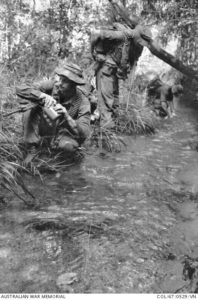Bob Hall and Andrew Ross
Requirement
Dismounted soldiers require a safe and adequate supply of water to sustain them in the field. The amount of water thought to be required by a soldier on operations in Vietnam could vary widely. According to Medicine at War, a soldier on operations could require up to 23 litres of water per day.[1] But at least one former infantry battalion CO whose service experience was extensive and included operations in Malaya, put the amount of water required at a much lower 3 – 5 litres rising to 10 litres per day if the soldier was working very hard.[2]
The army was aware of research being done elsewhere on the water requirements of soldiers under operational conditions in hot climates. In January 1969 the Directorate of Military Training (DMT) circulated the results of some South African research on water requirements in hot climates. Of particular interest was the effect of limited water intake on marksmanship:
30 men were observed during 2 days when they walked at 3-3.5 m.p.h. [4.8 – 5.6 kph] for 25 miles [40.2 kilometres] carrying packs weighing about 45 lb [20.4 kg] over a desert-like area. Climate conditions were not severe, the highest globe temperature being 112 degrees F, while dry-bulb temperatures remained below 85 degrees F. Nevertheless, a group of 10 men given 2.04 litres of water per man daily became severely dehydrated. Body temperature rose above 102 degrees F, heart rates were rapid and sweat rates decreased. A second group given 4.54 litres per man daily performed fairly well on the first day but at completion of the walk on the second day, an average rectal temperature of 101 degrees F was recorded. Marksmanship of these two groups was poor, resulting in 15-20% lower scores than on control days. Appetites were poor and the men in both groups became listless and morose. In a third group given water ad libitum, body temperatures and heart rates were comparatively low and marksmanship was unaffected.[3]
Following their digestion of this South African research, the Directorate of Military Training commented that:
From the logistics viewpoint, water ad libitum is difficult to cater for in areas where water is scarce. However, a useful rule of thumb in the tropics is: 10 pints (4.73 litres) per man per day total fluid intake daily for everybody as the basic minimum; and an additional 1 pint (0.47 litres) per man for every hour of physical activity, i.e., marching.[4]
In view of the South African research, it seems that the supply of water recommended by DMT was at the very low end of the scale. It is perhaps little wonder that a company commander of 4RAR/NZ during the battalion’s second tour in 1971 wrote:
One of the principal and inescapable weights that all infantrymen carried in Vietnam was water, and it was a constant problem. The climate was extremely humid, and even the smallest exertion caused heavy sweating. Therefore each man carried six or even eight one-litre water bottles, each of which weighed 1.2 kilograms, and sometimes a waterbag which contained another three litres. The weight of the water alone could be between 11 and 13 kilograms. This water had to last the five days between resupplies, but it was never enough for comfort. Occasionally rainwater could be collected, or a creek might be encountered, which helped to alleviate the problem of dehydration. But thirst was every infantryman’s constant companion.[5]
Resupply

Private Colin Knowles of Launceston, TAS, a member of 3RAR, fills water bottles from bulk supplies at a Fire Support Base during Operation Coburg. The filled water bottles are packed into sandbags for delivery to troops on patrol. Sandbags containing filled water bottles can be seen in the background. On the left is a pile of empty jerry cans.
Infantrymen were expected, as far as possible, to find their water in the field. Water resupply by helicopter or other vehicle, though possible, was discouraged unless it was taken during a scheduled ration resupply. However, water delivered in this way had the advantage of being properly treated for consumption within Nui Dat before issue to the troops in the field. As a result, the use of water delivered through the resupply system tended to reduce the incidence of gastrointestinal infections among soldiers deployed in the field.
There were several problems with delivering water to dismounted soldiers in the field. First, large amounts of water were consumed and therefore, if water was to be provided in this way, frequent resupply was required. As we have shown elsewhere, commanders sought to eliminate or sharply reduce the number of helicopters or other vehicles entering their AO because this tended to alert the enemy to their presence. Second, water is a bulky and heavy commodity. If delivered in bulk form (for example, in jerry cans) there is often a great deal of spillage and it can take some time to decant into individual water bottles. Resupply of water in jerry cans often necess
itated a second helicopter sortie to return to the resupply site to backload the empty jerry cans. Various ways of fixing this problem were tried. One was to deliver water in filled water bottles packed in sandbags which were then swapped ‘filled for empty’ by the troops in the field. This technique reduced the resupply turnaround time substantially but required the unit to hold a very large stock of water bottles, potentially at least 10 per soldier.[6]

Vietnam, 1965. A US Army helicopter about to lift a slung load of empty jerry cans after a water resupply to 1RAR battalion group soldiers on top of ‘Brass Monkey’ north of Vo Xu village where 1 RAR was carrying out a search and destroy operation.
A third problem with water resupply to troops in the field was that if frequent resupply was required as was sometimes the case in the dry season, then water sometimes needed to be free-dropped to troops on the ground. Returning regularly to LZs where water could be air landed could limit patrol coverage of a target area. But free-dropping led to loss and also created the problem of backloading the delivery container. Experiments conducted with jerry cans showed that few survived being dropped through a high jungle canopy. Those that did survive presented the problem of what to do with the empty jerry can. The solution to this problem was eventually found with the use of a US 3 gallon [13.6 litre] water container specially designed for free-dropping without rupturing. Once empty it could be folded and carried.[7] This device could be free dropped full of water from a height of 150 feet, through jungle canopy, with an 80 per cent success rate.[8] An infantry company taking 100 per cent water resupply required 50 of these containers per resupply [680 litres in total]. They were folded and carried out of operations for later re-use although they had been designed as a single use item.
Winning water locally
The alternative to resupplying water in the field was to have soldiers find water locally and treat it for consumption. This preserved the security of deployed forces and freed them from being ‘tethered’ to LZs where regular water replenishment could take place. However, it too had problems. These were, first, that South Vietnam experienced a marked dry season. Local winning of water was quite possible in the wet season, but could be more difficult, though not impossible, during the dry. A range of techniques were used during the dry season to find water locally. These included issuing platoons with demolition charges to blow soaks in otherwise dry creek beds, building solar stills when in static positions, and issuing a range of devices for carrying bulk water. These devices included water bags of various kinds that could be slung or draped over a shoulder,[9] and collapsible jerry cans that required a soldier to carry them in his hand, thus preventing him from being available immediately, in the firing line.
The second problem was that winning water locally tended to increase the incidence of gastrointestinal infection among dismounted troops. Though each soldier was issued with a Millbank filter and a water sterilization kit, many soldiers failed to use them. In Medicine at War, the author, Brendan O’Keefe, notes that:
Troops on operations required up to 23 litres of water each per day for drinking and cooking. These supplies were supposed to be obtained through the use of Millbank filtration bags and chlorine sterilizing tablets.
… However, the Millbank bags proved too slow-working for use on operations.[10]
Lieutenant Colonel M.A. Naughton, the Assistant Director of Medical Services, was concerned about peaks in the occurrence of gastrointestinal disease among Australian soldiers in Vietnam. He hoped to identify a cause or causes for the increases so that he could take appropriate steps to reduce the number of cases. His investigation of the problem quickly led him to the standard of water sterilization in the field. O’Keefe writes:
Officers, Naughton discovered, considered that the slow filtration action of Millbank bags made them tactically unacceptable and they were therefore not insisting that soldiers use them on operations. Instead, the soldiers, acting on orders, simply filled their water bottles direct from streams as they crossed them. Though scarcely ideal, this was not so bad as long as soldiers took care to sterilize the water. But the soldiers only infrequently used the American iodine sterilizing tablets with which they had been issued from May 1968, because they did not like the unpleasant taste and the strong iodoform smell that the tablets gave the water. Many soldiers believed in any case that clear, running water following rain was fit to drink without any sterilization. It was this consumption of unfiltered and unsterilised water that Naughton saw as a major contributor to the increased incidence of gastrointestinal infections.[11]
Naughton realized that there was little that could be done about field filtration. Any method of filtering would be too slow. But he could fix the problem of water sterilization. He ordered from Australia large quantities of water sterilization kits that contained chlorine tablets and de-tasting tablets. The de-tasting tablets were supposed to render the water free of any chlorine taste. Naughton ordered that soldiers should apply two chlorine tablets per filled water bottle, instead of the usual one. He hoped to achieve improved sterilization in this way.[12] While gastrointestinal infections may have reduced as a result, some soldiers still failed to properly use the sterilizing kit. Officer and NCO leadership and supervision was an important issue in ensuring soldiers treated their water. Many soldiers felt that the de-tasting tablets made little difference to the taste and they were often left behind though the chlorine tablets themselves were taken into the field.
Implications for load carrying
The amount of water available to dismounted soldiers was at the low end of acceptable limits. Operations in the wet season, when water could be found locally with relative ease, resulted in soldiers carrying relatively light water loads. In the dry season, however, soldiers might carry six to eight 1 litre water bottles plus one or more water ‘bladders’ holding 3 litres. This amount of water imposed a considerable load on the soldier.
As with ration resupply, commanders hoped to avoid water resupply or to lengthen the gap between resupplies as much as possible. Air landed water resupplies using bulk containers were lengthy and usually required at least two helicopter sorties. Air dropping of water only became effective when special equipment became available from US sources.
The difficulties of resupply of water tended to encourage efforts to locally win water. In turn, this required soldiers to carry Millbank filters and sterilizing kits. Entrenching tools and slabs of C4 explosives (plus detonators, safety fuze, etc) were carried in part to dig or blow soaks but these explosives also added to the soldier’s load. The main disadvantage of winning water locally was the level of gastrointestinal infection that resulted from soldiers failing to use their sterilizing kits properly. This could lead to sick soldiers being evacuated from the field to Nui Dat and their patrol being short-handed.
Bibliography
[1] Brendan O’Keefe, with F.B. Smith, Medicine at War: Medical Aspects of Australia’s involvement in Southeast Asia 1950-1972, Allen & Unwin, in association with the Australian War Memorial, St Leonards, 1994, p. 77.
[2] LTCOL J.O.L. Langtry, ‘Man-the-weapon: Neglected Aspects of Leader Training’, Australian Army Journal: A Periodical Review of Military Literature, no. 202, March 1966, p. 3.
[3] AWM290, item 2/R810/6/20, 2RAR extract – Training information – Lessons Learned. Training Information DMT 1/69 dated 13 Jan 69. The outline of the research had been extracted from Strydom, N.B., Van Graan, C.H. Viijoen, J.H. & Benade, A.J.S., Physiological performance of men subjected to difference water regimes over a two-day period. [sic] South African Medical Journal, J. 1968, v. 42, no. 5, pp 92-5.
[4] AWM290, item 2/R810/6/20, 2RAR extract – Training information – Lessons Learned. Training Information DMT 1/69 dated 13 Jan 69.
[5] Jerry Taylor, Last Out: 4RAR/NZ (ANZAC) Battalion’s second tour in Vietnam, Allen & Unwin, Sydney, 2001, p. 54.
[6] AWM98, item R895/3/2, Water, Supplies – Operational Water Re-Supply. Memo, Brig S.C. Graham, Comd 1ATF to HQ AFV, ‘Operational Water Re-Supply – Use of Water Bottles, 11 May 67. In this technique, empty water bottles were packed in fives into sandbags. When the resupply helicopter arrived these were loaded in one side of the helicopter as sandbags containing five filled water bottles were unloaded off the other. This provided very quick helicopter turn around.
[7] AWM98, item R8465/1/6, Individual Equipment Containers – Water Collapsible. Memo, Brigadier S.P. Weir, Comd 1ATF, to HQ AFV dated 30 Sep 69, titled ‘Provision of Water Carrying Equipment for Field Elements’.
[8] AWM103, item R895/1/1, HQ 1ATF, Water, General, Plastic 4 Gallon Water Cans. Sig 1ATF to Austforce Vietnam, 30 May 71.
[9] See AWM98, item R8465/1/6, Individual Equipment Containers – Water Collapsible in which a number of devices, some purchased privately by soldiers, were considered.
[10] O’Keefe, Medicine at War, p. 77.
[11] O’Keefe, Medicine at War, p. 176.
[12] O’Keefe, Medicine at War, p. 176.



One Comment on “Keeping the Troops in the Field. Part 2: Water Resupply”
I recall one time during the dry in SVN our platoon was short of water-so short that I had considered urinating into a water bottle to slake my thirst once everyone was bedded down (bet I wasn’t the only one with such thoughts). Fortunately that night it bucketed down and next day we all had (more than) ample water and the morale was once again sky high. My appreciation of the humble drink of water is attributed to that night!! Have since found out that “waste water” from the body would not have been too beneficial health-wise.